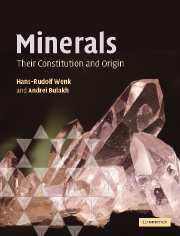Book contents
- Frontmatter
- Contents
- Preface
- Acknowledgments
- Figure credits
- Part I Structural features of minerals
- Part II Physical investigation of minerals
- 7 Experimental studies of crystal structures. X-ray diffraction
- 8 Physical properties
- 9 Optical properties
- 10 Identification of minerals with the petrographic microscope
- 11 Color
- 12 Additional analytical methods
- 13 Mechanical properties and deformation
- Part III Variety of minerals and mineral-forming processes
- Part IV A systematic look at mineral groups
- Part V Applied mineralogy
- Appendices
- Glossary
- References
- Index
- Plate section
- References
13 - Mechanical properties and deformation
from Part II - Physical investigation of minerals
- Frontmatter
- Contents
- Preface
- Acknowledgments
- Figure credits
- Part I Structural features of minerals
- Part II Physical investigation of minerals
- 7 Experimental studies of crystal structures. X-ray diffraction
- 8 Physical properties
- 9 Optical properties
- 10 Identification of minerals with the petrographic microscope
- 11 Color
- 12 Additional analytical methods
- 13 Mechanical properties and deformation
- Part III Variety of minerals and mineral-forming processes
- Part IV A systematic look at mineral groups
- Part V Applied mineralogy
- Appendices
- Glossary
- References
- Index
- Plate section
- References
Summary
Stress–strain
In Chapter 8 we explored the intrinsic physical properties of minerals that uniquely relate physical quantities and are described by a single number or a set of coefficients. Density, thermal conductivity, and elastic properties are examples. These properties depend on composition and structure and may vary slightly with temperature and pressure. The mechanical properties of minerals are more complicated because they are greatly modified during a crystal's history. In this chapter we will explore how crystals deform.
We start our discussion with a few basic definitions. If we apply a compressive force F to the surface of a crystal, we impose a deformation apparent in a change in length (Δ l) and correspondingly by a change in area (Figure 13.1a). Force per surface area is called stress σ, and the resulting deformation (Δ l/l) is called strain ε. We have briefly introduced stress and strain in Chapter 8 as second-rank tensors. Both properties are highly directional.
In Figure 13.1b we show the evolution of strain as a function of applied stress. The stress-strain curve generally has three segments. In the first segment (regime 1), strain increases almost linearly with stress. If the stress is removed, the strain returns to its original value. In this reversible elastic range, deformation occurs by compression of bonds and can be described fully with the elastic tensor. No bonds are broken in this regime. In some directions the crystal compresses more easily than in others.
- Type
- Chapter
- Information
- MineralsTheir Constitution and Origin, pp. 245 - 252Publisher: Cambridge University PressPrint publication year: 2004



